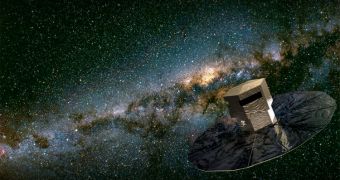The European Space Agency's (EAS) Gaia spacecraft has recently achieved an impressive milestone in its development, when its sunshield was deployed for the very first time. Mission controllers say that the probe remains well on track for a 2013 launch.
At first, the name Gaia stood for Global Astrometric Interferometer for Astrophysics, but the optical interferometry technique it was to use was eventually changed. The name, however, endured.
The probe is meant to conduct a massive census of the galaxy, mapping billions of stars inside the Milky Way for future reference. It will remain operational for at least 5 years, during which time it will survey each of the star in its field of view about 70 times.
This is one of the most ambitious space survey missions ever developed. Through it, ESA is again affirming its role as a critically-important actor in space exploration today. The agency will also be using Gaia to search for exoplanets and brown dwarfs.
At the same time, Gaia will also focus on the solar system, searching for hundreds of thousands of currently-unknown asteroids. These datasets will then be combined with existing ones, kept by NASA, so that experts can gain a better understanding of our cosmic understanding.
But before any of this becomes reality, the spacecraft needs to launch from the ESA Kourou Spaceport, in French Guiana, South America. The probe will be carried in space by a Soyuz rocket and a Fregat upper stage, both manufactured by Russians.
In the meantime, achieving success in sunshield testing is an important milestone. The role this component has is absolutely critical to Gaia's capabilities – keep its instruments cooled to around minus 110 degrees Celsius (minus 166 degrees Fahrenheit).
The thing about this particular sunshield is that it cannot be launched in its final configuration, since it has a diameter of about 10 meters (34 feet). As such, it is installed on a series of folding panels, which need to be able to deploy correctly in the harsh conditions of space.
“Since the sunshield is designed for the weightlessness of space, it cannot support its own weight on Earth. So, during this test at Astrium in Toulouse, France, support cables and counterweights simulated weightless conditions and provided a realistic trial,” an ESA press release reports.
When the actual spacecraft reaches space, it will take about 20 minutes for its sunshield to fully deploy. Overall, Gaia is expected to discover about 15,000 exoplanets during its mission.

 14 DAY TRIAL //
14 DAY TRIAL //